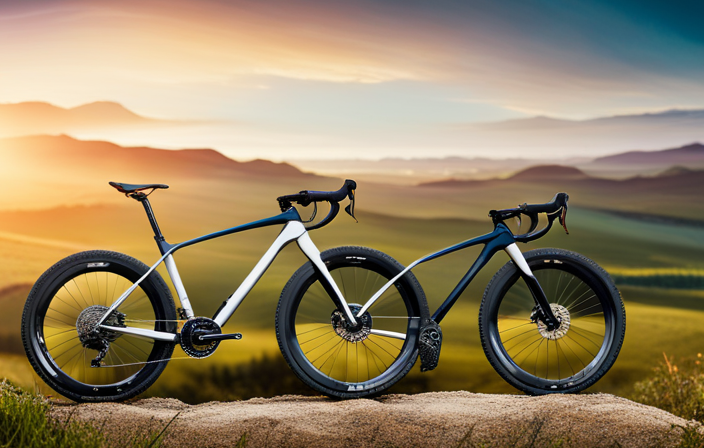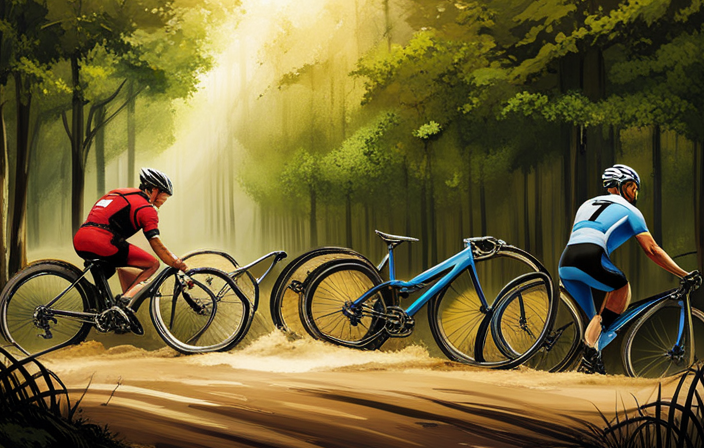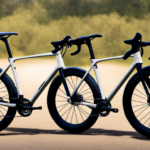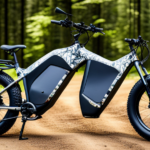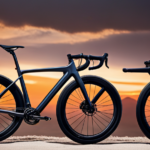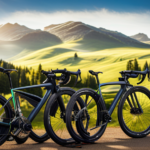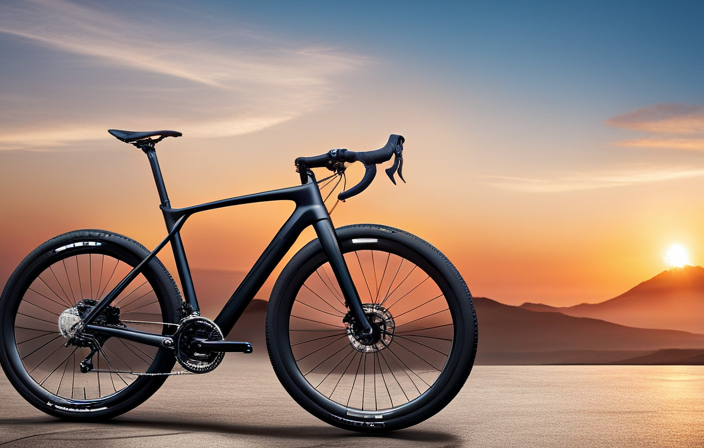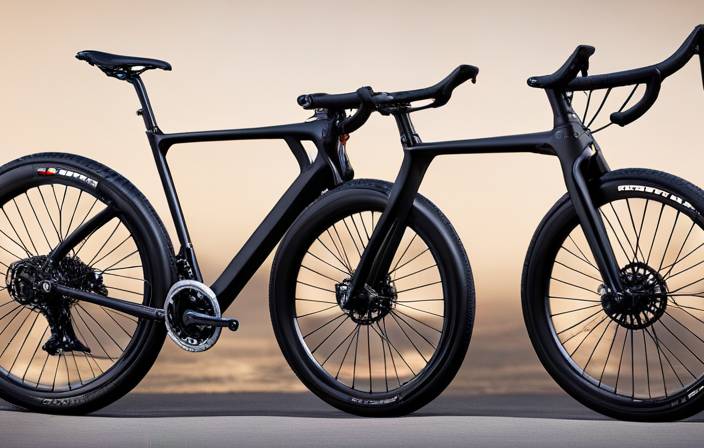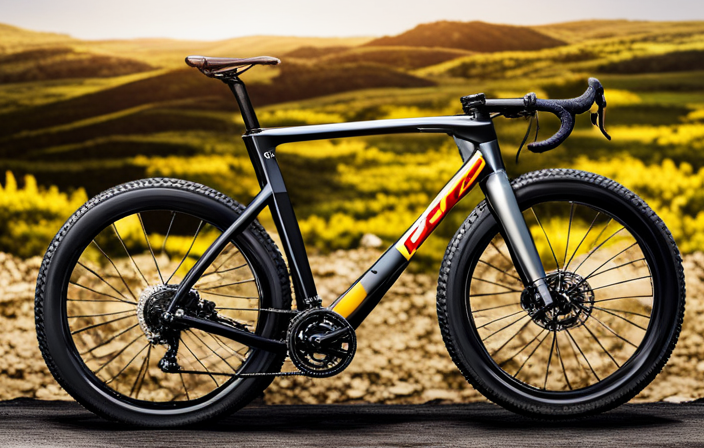Picture yourself navigating through a wild and rough terrain, with the sound of gravel under your wheels syncing with your heartbeat. The wind blowing through your hair as you tackle difficult terrains and discover new realms of excitement.
Why on earth would anyone want a gravel bike? Because it offers an unparalleled sense of freedom and exploration.
In this article, I will passionately delve into the reasons why these versatile machines have captured the hearts of cyclists everywhere and why they are an essential addition to any adventurer’s arsenal.
Key Takeaways
- Gravel bikes can handle various terrains effortlessly, including rough gravel roads, dirt paths, and light off-road adventures.
- Gravel bikes offer a smooth and comfortable ride, with wider tires and suspension features that absorb bumps and vibrations.
- Gravel bikes provide increased stability and control on various terrains, with wider tires and aggressive tread patterns for excellent traction.
- Gravel biking allows for exploration of uncharted paths, uncovering hidden gems in nature and providing a sense of adventure and discovery.
Versatility on Different Terrains
You’ll love how a gravel bike can effortlessly handle various terrains. When it comes to versatility, the gravel bike truly shines. Unlike road bikes that are limited to smooth pavement and mountain bikes built for rugged trails, gravel bikes offer the best of both worlds. They can tackle rough gravel roads, dirt paths, and even some light off-road adventures with ease.
Sure, there are drawbacks to owning a gravel bike. The wider tires may not be as efficient on paved roads compared to a sleek road bike. And while it can handle some off-road terrain, it’s not as capable as a full-fledged mountain bike designed for extreme trails. However, if you’re someone who loves exploring different landscapes and wants the freedom to go wherever your two wheels take you, then a gravel bike is the perfect choice.
Compared to mountain bikes, which can feel heavy and sluggish on smooth surfaces, gravel bikes provide a smoother and more comfortable ride due to their relaxed geometry and wider tires. This means you can enjoy long rides without feeling every little bump in the road.
So get ready for an adventure-filled journey with your versatile gravel bike that offers both excitement and comfort at every turn.
Smooth and Comfortable Ride
One of the benefits of a gravel bike is that it offers a smooth and comfortable ride. When I hop on my gravel bike and hit the trails, every pedal stroke feels like floating on air. The combination of wider tires and suspension features absorb the bumps and vibrations, ensuring a smooth ride even on rough terrains. It’s like gliding effortlessly over rocks, roots, and potholes, without feeling every jolt in my body.
To give you an idea of just how smooth and comfortable the ride can be, imagine cruising down a gravel path with ease. Picture yourself surrounded by lush greenery on both sides as you pedal along at a steady pace. The tires grip the ground firmly, providing stability as you navigate through twists and turns. The suspension system absorbs any impact from uneven surfaces, giving you a buttery-smooth experience throughout your ride.
Not only does this smooth ride enhance comfort, but it also allows for better control over the bike. With each bump smoothed out by the suspension system, I feel confident in my ability to maneuver through any terrain. This increased stability and control make riding a gravel bike an exhilarating adventure rather than a bumpy struggle.
With such a smooth and comfortable experience provided by gravel bikes, it’s no wonder why they’re gaining popularity among cycling enthusiasts looking for versatility on different terrains.
Increased Stability and Control
When riding a gravel bike, I can’t help but marvel at the increased stability and control it provides on various terrains. It’s like gliding effortlessly over gravel roads, dirt paths, and even rough trails. This level of stability allows me to ride with confidence and push the limits of my speed. With every pedal stroke, I feel in complete control of the bike, which translates into improved traction and maneuverability.
One of the main reasons for this enhanced stability is the design of gravel bikes. They typically feature wider tires with more aggressive tread patterns compared to road bikes. These tires grip the surface better, providing excellent traction even on loose or uneven terrain. Whether I’m tackling steep climbs or descending fast down rocky descents, I can rely on my gravel bike to keep me upright and in command.
The increased stability and control offered by a gravel bike not only make riding more enjoyable but also expand your horizons as a cyclist. With this level of confidence in your equipment, you can venture off-road and explore new routes and trails that were previously inaccessible on a traditional road bike. So get ready to experience thrilling adventures as you transition from smooth pavement to challenging off-road tracks without missing a beat!
Ability to Explore New Routes and Trails
As I ride my gravel bike, I’ve discovered a whole new world of routes and trails waiting to be explored. It’s exhilarating to venture off the beaten path and explore uncharted paths that are inaccessible to road bikes. Gravel biking allows me to find hidden gems in nature, places that are tucked away from the hustle and bustle of city life.
One of the greatest joys of gravel biking is the ability to go where no one else has gone before. Whether it’s a winding forest trail or a rocky mountain pass, every ride is an opportunity for adventure and discovery. The versatility of a gravel bike allows me to navigate through different terrains with ease, giving me the freedom to explore new routes without limitations.
Exploring these unexplored paths not only satisfies my curiosity but also provides a sense of accomplishment. Finding hidden gems along the way, like secluded lakes or breathtaking viewpoints, makes each ride more memorable and worthwhile. It’s like embarking on a treasure hunt every time I hop on my gravel bike.
So as you embark on your own gravel biking journey, prepare yourself for an experience filled with adventure and exploration. Get ready to uncover new trails, witness stunning landscapes, and discover the beauty that lies beyond what meets the eye. Your next ride will open doors to endless possibilities without ever taking a step out of your comfort zone.
Adventure and Exploration
Get ready to embark on an exciting journey of adventure and exploration as you hop on your gravel bike. With its versatility and off-road capabilities, a gravel bike opens up a whole new world of possibilities for adventure tourism and off-road cycling enthusiasts. Whether it’s exploring remote trails, conquering challenging terrains, or simply immersing yourself in the beauty of nature, a gravel bike takes you places that traditional road bikes can’t.
Adventure tourism is all about seeking thrilling experiences in unique destinations, and a gravel bike perfectly fits the bill. It allows you to venture into uncharted territories, discovering hidden gems that are inaccessible by car or foot. The adrenaline rush you feel as you navigate through rugged landscapes and conquer obstacles is truly unmatched.
Off-road cycling enthusiasts will find their hearts racing with excitement as they tackle rough terrains on their trusty gravel bikes. From muddy trails to rocky paths, these bikes can handle it all with ease and grace. Every ride becomes an exhilarating experience filled with challenges and triumphs.
As we delve deeper into the discussion about why anyone would want a gravel bike, it’s important to note that they are not just suitable for short joyrides but also excel at long-distance cycling adventures. So get ready to discover why these versatile machines are perfect companions for those who crave both thrill and endurance…
Suitable for Long-Distance Cycling
If you’re looking to embark on long-distance cycling adventures, a gravel bike is the perfect companion for you. Not only does it offer a smooth ride on rough terrains, but it also provides the necessary features for long distance endurance. One of the key advantages of a gravel bike for long-distance cycling is its versatility. It allows riders to switch between various surfaces effortlessly, from pavement to gravel roads and even light trails. This adaptability ensures that you can tackle any route without compromising speed or comfort.
Furthermore, gravel bikes are designed with training benefits in mind. The geometry of these bikes encourages an upright position, reducing strain on the back and neck during those long hours in the saddle. Additionally, they often come equipped with wider tires that provide better traction and stability, making them ideal for tackling challenging terrains.
To emphasize these points further:
| Versatility | Training Benefits | Endurance |
|---|---|---|
| Smooth transition between surfaces | Upright riding position reduces strain | Designed for long hours in saddle |
| Suitable for multiple types of terrain | Wider tires provide better traction and stability | Can handle rough conditions |
With their ability to conquer different terrains and their focus on rider comfort and performance, gravel bikes are undoubtedly well-suited for long-distance cycling endeavors.
Moving forward into our next section about the ability to carry gear and supplies…
Ability to Carry Gear and Supplies
You can easily transport all your necessary gear and supplies on a gravel bike. One of the key advantages of these bikes is their impressive carrying capacity, which allows you to embark on long-distance adventures with peace of mind. Whether you’re planning a multi-day camping trip or simply need to haul groceries back home, a gravel bike has got you covered.
The durability and reliability of these bikes make them ideal for carrying heavy loads. Designed to handle rough terrains and unpredictable conditions, gravel bikes are built tough. With sturdy frames, reinforced wheels, and reliable components, they can withstand the weight and strain of your gear without compromising performance.
Personally, I love the freedom that comes with being able to carry everything I need on my gravel bike. It eliminates the need for additional equipment like panniers or trailers, streamlining my setup and allowing me to focus on the ride itself.
Now let’s talk about lower maintenance requirements.
Lower Maintenance Requirements
One of the benefits of a gravel bike is that it requires less maintenance compared to other types of bicycles. This is a huge advantage for riders who want to spend more time on the road and less time in the workshop.
Here are three reasons why lower maintenance requirements make a gravel bike a cost-effective investment:
-
Durability: Gravel bikes are built tough, with sturdy frames and components designed to withstand rough terrain. This means fewer repairs and replacements, saving you money in the long run.
-
All-weather performance: Gravel bikes are made to handle any weather conditions, from rain and mud to snow and ice. With proper care, they can keep performing at their best without requiring frequent tune-ups or adjustments.
-
Easy DIY fixes: The simplicity of gravel bikes makes them easy to maintain even for beginners. From changing tires to adjusting brakes, most basic repairs can be done at home with minimal tools and knowledge.
Lower maintenance requirements not only save you money but also give you peace of mind knowing that your bike will always be ready for your next adventure.
And speaking of adventures, gravel bikes are also ideal for commuting and urban cycling due to their versatility and comfort. So whether you’re hitting the trails or navigating city streets, a gravel bike is a reliable companion that won’t let you down.
Ideal for Commuting and Urban Cycling
As I mentioned earlier, one of the reasons why gravel bikes are gaining popularity is because they have lower maintenance requirements compared to other types of bicycles. But that’s not the only reason why these versatile machines are loved by many. Let me tell you about another fantastic aspect of gravel bikes: their suitability for commuting and urban cycling.
When it comes to getting around town or navigating busy city streets, gravel bikes offer numerous benefits. With their sturdy frames, wider tires, and relaxed geometry, they provide a comfortable and stable ride on various road surfaces. Whether you encounter potholes, uneven pavement, or even the occasional curb jump, a gravel bike can handle it all with ease.
Additionally, gravel bikes often come equipped with mounts for racks and fenders, making them practical choices for carrying essentials like bags or panniers during your daily commute. The ability to customize your setup further enhances their versatility in an urban setting.
Not only do gravel bikes excel in functionality and convenience for commuting purposes, but they also offer advantages specific to urban cycling. Their agile handling allows quick maneuvering through traffic while maintaining stability. The wider tires provide better traction on slick surfaces like wet roads or tram tracks.
Now that we’ve explored the benefits of using a gravel bike for commuting and urban cycling let’s move on to another exciting aspect: the fun and exhilarating riding experience these incredible machines deliver.
Fun and Exciting Riding Experience
Riding a gravel bike is an absolute blast, providing a thrilling and exhilarating experience on the road. It’s not just about getting from point A to point B; it’s about the journey itself. One of the reasons why I love riding a gravel bike is because of the fun group rides you can have with fellow enthusiasts. There’s something special about joining a pack of riders, conquering challenging terrains together, and pushing each other to new limits. The camaraderie and shared experiences create lasting memories that make every ride unforgettable.
Not only does riding a gravel bike provide fun group rides, but it also gives you an adrenaline rush like no other. The feeling of speeding down dirt trails or tackling steep descents is pure excitement. You can’t help but feel alive as you navigate through unpredictable terrain, constantly adjusting your body position and feeling the vibrations beneath your tires.
Transitioning into the next section about ‘great for fitness and exercise,’ riding a gravel bike isn’t just about having fun and seeking thrills; it’s also an excellent form of exercise. So if you’re looking for an activity that combines adventure, socialization, and fitness all in one package, then hop on a gravel bike and get ready for an incredible experience!
Great for Fitness and Exercise
Get ready to experience a fantastic workout and improve your fitness levels by hopping on a gravel bike. Gravel biking is not just about the thrill and adventure, it also offers incredible benefits for your physical well-being.
One of the greatest advantages of riding a gravel bike is its effectiveness in weight loss. The combination of off-road terrain and constant pedaling engages multiple muscle groups and burns calories like no other. It’s an exhilarating way to shed those extra pounds while enjoying yourself in nature.
In addition to weight loss, gravel biking also provides significant cardiovascular benefits. As you navigate through rugged trails, your heart rate increases, pumping oxygen-rich blood throughout your body. This helps strengthen your heart muscles and improves overall cardiovascular health. Not only will you feel more energized during rides, but regular gravel biking can also reduce the risk of heart diseases in the long run.
By choosing a gravel bike as your fitness companion, you’re not just getting a great workout; you’re connecting with nature and the outdoors on a whole new level. Exploring scenic landscapes, breathing in fresh air, and feeling the adrenaline rush as you conquer challenging terrains are experiences that go beyond mere exercise routines.
So get ready to embark on an exciting journey that will boost your fitness levels while allowing you to connect with nature’s beauty without taking any steps towards it!
Connect with Nature and the Outdoors
After discussing how gravel bikes are great for fitness and exercise, let’s now explore another reason why these bikes are so appealing: they allow you to connect with nature and enjoy outdoor activities like never before.
-
Immerse yourself in nature: Riding a gravel bike takes you off the beaten path and onto trails that wind through beautiful landscapes. You can pedal through lush forests, along scenic riversides, or up challenging mountain paths, all while breathing in the fresh air and feeling a sense of tranquility.
-
Experience the thrill of exploration: Gravel biking opens up a world of adventure where you can discover hidden gems that cars can’t reach. Explore remote areas, stumble upon breathtaking vistas, or stumble upon a secret swimming hole – every ride is an opportunity to uncover something new.
-
Escape the hustle and bustle: In today’s fast-paced world, it’s essential to find moments of peace and solitude. Gravel biking allows you to escape from crowded streets and noisy traffic, immersing yourself in nature’s serenity instead.
-
Get closer to wildlife: When riding on gravel roads or trails, you’ll often come across wildlife such as deer grazing in meadows or birds soaring above treetops. It’s an incredible feeling to witness these creatures in their natural habitat and feel connected to the wild around us.
By connecting with nature through gravel biking, we can truly appreciate the beauty of our surroundings while engaging in invigorating outdoor activities.
So now that we’ve explored this aspect, let’s dive into how you can join the gravel cycling community…
Join the Gravel Cycling Community
To become part of the gravel cycling community, it’s important to connect with like-minded individuals who share your passion for exploring the great outdoors. Joining this tight-knit group of adventurers will not only provide you with a sense of belonging but also open up a world of exciting opportunities and new friendships.
In order to grab your attention and showcase the vibrant gravel cycling community, let me introduce you to a few key aspects in the form of a table:
| Community Events | Online Forums | Local Riding Groups |
|---|---|---|
| Gravel races | Cycling forums | Group rides |
| Bikepacking trips | Social media | Trail maintenance |
| Adventure tours | Gear discussions | Skills workshops |
By participating in these activities, you’ll be able to surround yourself with fellow gravel enthusiasts who are eager to share their experiences and knowledge. The support and camaraderie within this community are unmatched, providing endless opportunities for growth and excitement.
Joining the gravel cycling movement is not just about riding bikes; it’s about embracing a lifestyle that encourages exploration, self-discovery, and pushing your limits. In the next section, we’ll delve into how gravel cycling allows you to test your skills on challenging terrains while expanding your horizons.
Test Your Cycling Skills and Push Your Limits
By challenging yourself on various terrains, gravel cycling allows you to push your limits and test your skills. It’s not just about riding on smooth roads or cruising through flat landscapes. Gravel biking takes you off the beaten path and throws obstacles at you that demand endurance, strength, and agility.
Here are three reasons why gravel cycling is the ultimate test for any cyclist:
-
Navigate unpredictable terrain: Gravel roads can be rough, uneven, and full of surprises. Riding on these challenging surfaces requires quick thinking, precise handling, and excellent bike control. You’ll encounter loose rocks, mud pits, steep climbs, and unexpected turns that will keep you on your toes.
-
Build physical endurance: As a gravel cyclist, you’ll face longer distances and more demanding routes compared to traditional road cycling. The constant changes in terrain force you to engage different muscle groups while maintaining a steady pace. This builds both cardiovascular fitness and muscular endurance.
-
Hone technical skills: Gravel cycling demands mastery of various techniques like cornering on loose surfaces, descending safely down rocky slopes, and maneuvering through tricky obstacles. These skills not only improve your performance off-road but also enhance your overall cycling abilities.
So don’t shy away from the challenge! Embrace the sense of adventure that comes with gravel biking as we dive into how it opens up a whole new world of exploration and thrill-seeking opportunities.
Embrace the Challenge and Sense of Adventure
Embrace the challenge and sense of adventure that comes with gravel cycling, as you discover a whole new world of exploration and excitement. Gravel biking is not just about riding on smooth roads or well-maintained trails; it’s about pushing your limits and testing your skills in unpredictable terrains. It offers a unique experience that combines the thrill of mountain biking with the endurance of road cycling.
Gravel biking allows you to venture off the beaten path and explore places that are inaccessible by traditional bikes. Whether it’s a rugged mountain trail or a winding country road, every ride becomes an opportunity for personal growth and self-discovery. The sense of accomplishment you feel when conquering challenging terrain is unparalleled.
To give you a glimpse into this exhilarating world, imagine yourself pedaling through dense forests, splashing through muddy puddles, and conquering steep hills. As you navigate these obstacles, your body becomes stronger, your mind more focused, and your spirit invigorated.
But don’t just take my word for it – let me show you why gravel cycling is worth embracing:
| Gravel Cycling Benefits | |
|---|---|
| 1 | Sense of Accomplishment |
| 2 | Personal Growth |
| 3 | Exploration |
| 4 | Excitement |
By embracing the challenge and sense of adventure that gravel cycling offers, you can unlock endless possibilities for personal growth while experiencing the joy of exploring uncharted territories. So grab your bike, hit the gravel roads, and embark on an unforgettable journey filled with moments that will leave lasting memories!
Frequently Asked Questions
What are the main components of a gravel bike and why are they different from other types of bikes?
Gravel bikes are equipped with specific components that make them perfect for off-road adventures. One key component is the wider tires, which provide better traction on uneven surfaces.
The frame geometry is also unique, offering a more relaxed and comfortable riding position.
Gravel bikes often have disc brakes for reliable stopping power in all conditions.
These advantages set gravel bikes apart from other types of bikes and make them ideal for exploring unpaved roads and trails with confidence and excitement.
How does riding a gravel bike compare to riding a road bike or a mountain bike?
Riding a gravel bike offers a unique and exhilarating experience compared to road or mountain biking. These versatile machines combine the best of road and off-road capabilities, making them perfect for adventure seekers. Gravel bikes are becoming increasingly popular, with sales growing by 66% in the past year alone.
Compared to cyclocross bikes, gravel bikes offer a more comfortable ride on rough terrains. They excel at tackling long distances on mixed surfaces while providing stability and control. However, they may not be as nimble or efficient as road bikes on smooth pavement.
Overall, riding a gravel bike allows you to explore new routes and push your limits in style.
Are there any specific skills or techniques required for riding a gravel bike?
When it comes to riding a gravel bike, there are definitely some specific skills and techniques that come into play. Riding on loose surfaces requires good balance and control. You need to learn how to navigate through rough terrain while still maintaining speed.
Additionally, gravel bikes require regular maintenance due to the wear and tear they experience. It’s important to keep up with tire pressure, chain lubrication, and overall bike cleanliness for optimal performance on those adventurous rides.
Can a gravel bike be used for racing or competitive cycling?
Gravel bike racing is gaining popularity in the cycling world, and for good reason. These versatile bikes offer numerous benefits for competitive cycling.
One interesting statistic to consider is that gravel bike races have seen a 500% increase in participation over the past five years.
The benefits of using a gravel bike for racing include their ability to handle various terrains, their durability, and their versatility in adapting to different race conditions.
Gravel bikes truly offer a thrilling and challenging experience for competitive cyclists.
Are there any specific safety considerations or precautions to keep in mind when riding a gravel bike?
When riding a gravel bike, it’s important to prioritize safety. Regular maintenance is crucial to ensure the bike is in top condition. This includes checking tire pressure, inspecting brakes, and keeping the drivetrain clean.
Choosing the right tires for your gravel bike is also essential. Opt for wider tires with good grip and puncture protection.
These precautions will enhance your riding experience and minimize the risk of accidents on rough terrain.
Conclusion
In conclusion, I can’t stress enough how amazing gravel biking is. It’s like riding a wild stallion through uncharted territories, feeling the wind in your hair and the adrenaline pumping through your veins.
Imagine sailing through rugged terrains with ease, conquering steep hills and rocky trails like a true champion. It’s an experience that will push your limits and ignite a sense of adventure within you.
Don’t be afraid to embrace the challenge and join the gravel cycling community – trust me, once you try it, you’ll never want to ride anything else again.
